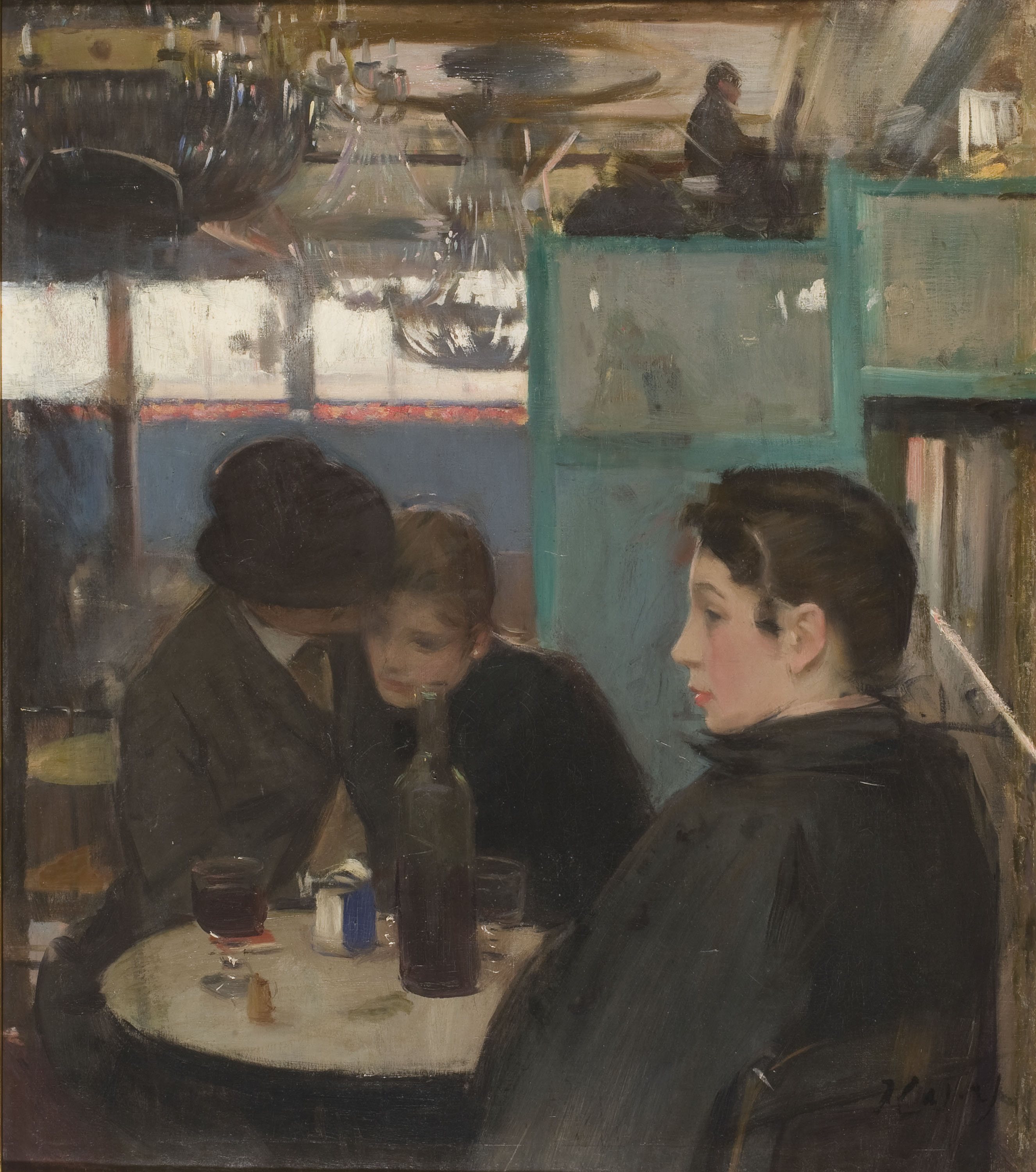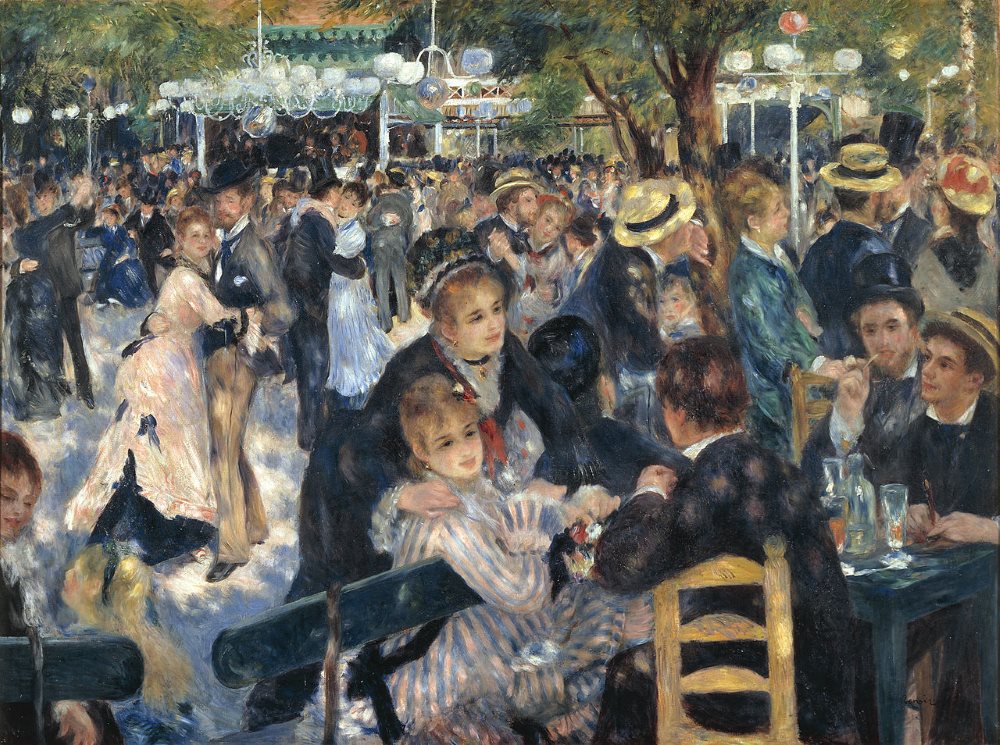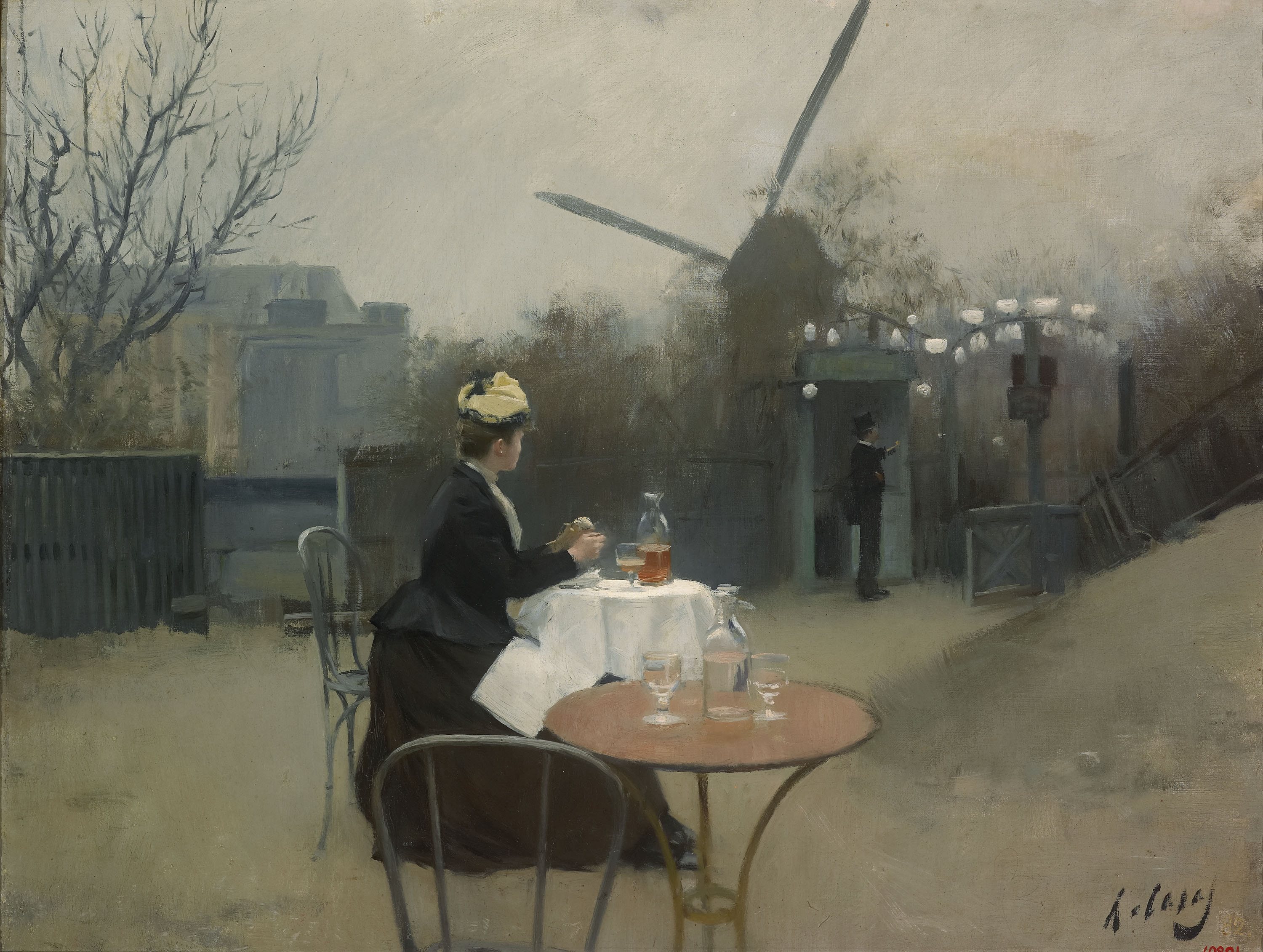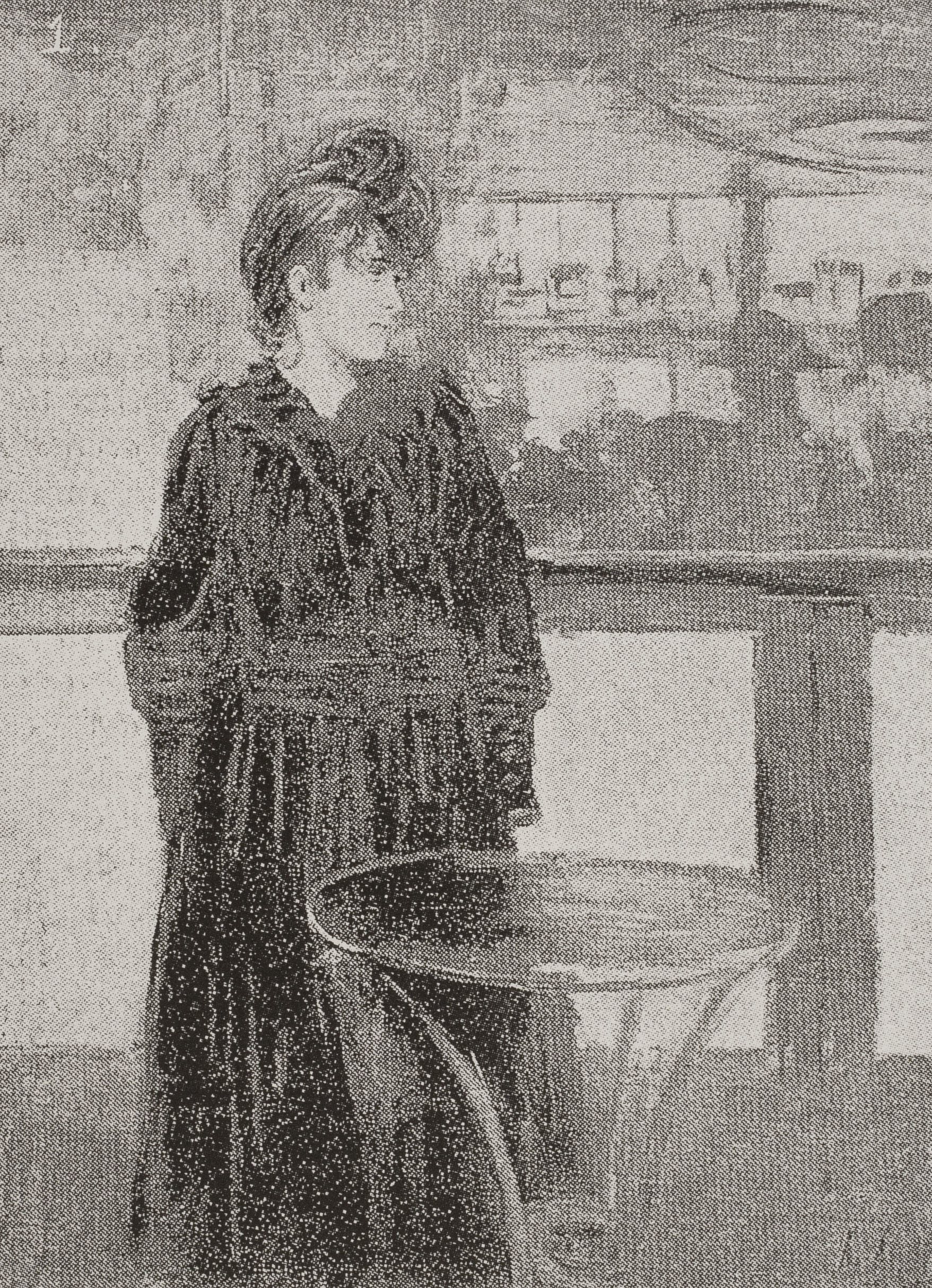Martí Casas
What story does Ramon Casas want to tell us in the painting Interior of Le Moulin de la Galette? It is one of the most enigmatic works by the great Modernista painter, a master specializing in portraiture who rarely painted complex subjects that could be interpreted in more than one way. The subject of the scene that we see, however, does not seem to be as insignificant as the majority of the landscapes and interiors that he painted during his career. Here one senses a conflict, a story of unhappiness that does not seem initially to have a clear explanation but which quickly captures the viewer’s attention.

Ramon Casas. Interior of Le Moulin de la Galette, around 1890-1891
The work shows us the famous dancehall in the Montmartre district, which stood inside a larger recreational area that included gardens, fairground attractions and the windmill that the place was named after. In the painting, the dance session has already begun, because we see the musicians playing on the dais, but the atmosphere does not seem to be very lively (the place is virtually empty), nor do the three figures in the foreground seem to feel much like moving their bodies. The one closest to the viewer is a young woman in profile who is looking at something outside the painting. We don’t know what she sees, but she obviously doesn’t like it, because on her serious face there is a sad melancholic look.
Across the table, there is a couple in each other’s arms. The man, his face hidden beneath a top hat, is caressing his companion, who also seems upset. We sense this due to the serious expression and the lost, glazed look. He must be consoling her. Although the three people are seated around the same table, as if they were friends or knew each other, there is no visual contact between the couple and the young woman. They are all self-absorbed. The dancehall’s dead atmosphere increases the people’s feeling of loneliness and the scene’s image of decadence and sadness.
Why are the people in Interior of Le Moulin de la Galette unhappy? Historians have put forward several theories, but before commenting on them let us place the painting in its context.
Paris 1900

Ramon Casas. Le Sacré Coeur, Montmartre. Paris, around 1900
Around 1900 Paris was the world’s art capital, and everyone who wanted to be a successful artist made sure they went there. Although Ramon Casas stayed there on several occasions, the most important one in his career was with Santiago Rusiñol between the end of 1890 and April 1892. The fact of working side by side for several months in the City of Light at the height of its artistic glory significantly improved the quality of the work of both artists. Ramon Casas, a very erratic painter, experienced one of his most prolific, consistent and homogeneous periods in Paris. The presence of Rusiñol, a far more demanding artist with intellectual interests that Casas lacked, enriched his works and made them more profound. Rusiñol, who was less a skilful painter than his friend, painted more complex and elaborate compositions next to Casas.

Pierre-Auguste Renoir. Bal du Moulin de la Galette, 1876 (Public domain)
During this joint stay, the Montmartre district and very especially Le Moulin de la Galette, next to the flat where they lived, were to become the main subjects of their paintings. But unlike other artists, for instance Auguste Renoir in the very famous Dance at Le Moulin de la Galette, today at Musée d’Orsay, Casas and Rusiñol did not depict the dancehall at the busiest and most cheerful moments, but when it was emptier and had a more sordid and decadent look. Why this negative view of Le Moulin? On one hand, the two Catalan painters frequented this place during a particularly harsh, severe winter. At that time of year the Moulin seems to have been less crowded and the image was greyer and less colourful than in springtime. On the other, this dull appearance of the dancehall must have stimulated Santiago Rusiñol’s decadent and often melancholy spirit; he gave a very harsh, negative opinion of the dancehall in the reports that he periodically wrote in La Vanguardia entitled ‘From the Windmill’. This awful view of Le Moulin de la Galette, described almost as a hellish place where “nobody laughs, but everybody shouts”, is the one that Rusiñol captured in his paintings.

Santiago Rusiñol. Laboratory of La Galette. Paris, 1890-1891
Ramon Casas, who was more cheerful and carefree and felt far more comfortable in that world, surprisingly chose to show us this same pessimistic picture too. We do not know if it was because he shared Rusiñol’s opinion of the place or because he let himself be influenced by his friend’s melancholy gaze. The fact is that during the stay from 1890 to 1892 Ramon Casas completed different paintings in which Le Moulin de la Galette always appears looking bleak, both inside the dancehall and outside.

Ramon Casas. Dance at Moulin de la Galette, 1876 (Public domain)
The most masterly painting of this period is undoubtedly Dance at Le Moulin de la Galette, in the Cau Ferrat museum in Sitges, in which the painter, with a cold dark palette, shows us the dancehall from an aerial perspective that turns the figures into elusive shadows moving spasmodically in the middle of an almost empty dance floor.
The woman in Ramon Casas’ art
Along with this masterpiece showing a more general view, Casas painted several scenes at Le Moulin featuring a woman sitting and drinking alone (or practically alone), observing something outside the painting’s visible field.

Ramon Casas. Plein air. París, circa 1890-1891
We have at least three excellent paintings by the artist that share a female subject and a similar approach. On one hand, Plein air, which has a less dramatic tone than the other two because it is set outside Le Moulin, and this makes it less distressing. Contributing to this also is the fact that the protagonist appears dressed more elegantly, more respectably. And the fact that she turns her head away from the viewer prevents us from knowing her mood: her loneliness may be the reason for sadness and impatience, but it may also be that she is enjoying the moment.

Ramon Casas. Madeleine o Au Moulin de la Galette. París, 1892 (Public domain)
The other two works, painted inside the hall, are conceptually much closer. The first one is, precisely, Interior of Le Moulin de la Galette. The other one is the famous Madeleine in the Museu de Montserrat, surely the most iconic and popular of all the works Casas painted in Paris. In both of them, we see a female figure with a sad and worried face in the foreground clearly looking outside the painting. In the case of Madeleine, however, the reason for the unease seems clearer and more transparent: she is jealous of her lover. Through the reflection in the mirror, which gives us a wide view of the dancehall, we see that the woman is looking with suppressed anger at a couple dancing cheek to cheek in the middle of the floor. We thus get to the heart of the story behind the painting thanks to a singular pictorial resource that is also a nod to the great master Édouard Manet and his famous work A Bar at the Folies-Bergère, today at The Courtald Institute of Art.

Édouard Manet. A Bar at the Folies-Bergère, 1882 (Public domain)
Knowing the circumstances behind the story of Madeleine, could we apply the same formula to the mysterious Interior of Le Moulin de la Galette? Apparently so. Or at least, the historians have done so, suggesting that the sadness of the young woman seen in profile could have been caused by the discovery of her lover’s infidelity. The hardness of the face might express a mixture of feelings: anger, betrayal, jealousy. Other authors have gone even further and have mentioned the possibility that Ramon Casas might have wanted to tell two successive episodes of the same story here, based on different figures that appear together at the same time in the same place. Therefore, the woman seen in profile might be the artistic depiction of the first part of the story, the discovery of infidelity, and the couple across the table might describe the second part of the dispute: the unfaithful lover apologizes and justifies himself to the cheated partner and tries to console her in order to get her to forgive him.
The choice of the theory of jealousy seems correct if we bear in mind the review of this work published in the Diario Mercantil on 8 November 1891 as a result of its inclusion in the second exhibition that Casas put on at the Sala Parés, along with Santiago Rusiñol and Enric Clarasó. According to the newspaper, in a painting “entitled Jealousy, see in the foreground a very Parisian-looking young woman in profile witnessing the infidelity of her beau, who at a nearby table is lavishing attention on a more fortunate grisette”.
The newspaper’s reference to the work we are considering here seems evident, and the review writer’s confusion when mentioning its title is even more significant. Jealousy – or Jalousie, the original French title chosen by Ramon Casas – was the name of another painting included in the exhibition, which had appeared in La Vanguardia the day before. This painting seems to be a more explicit previous version of Madeleine, due both to the unmistakable title chosen by the painter and the surlier expression on the protagonist’s face, who seems to be biting her lip slightly in a clear show of suppressed rage.
The whereabouts of Jalousie have been unknown since it was exhibited in Barcelona in 1891. It is not the only work by Ramon Casas to have been lost: nor do we know the fate of those that he must have sold in Paris at that time. But the case of Jalousie is interesting because we know what the work was like thanks to several photographs, and as it was exhibited in Barcelona it must surely have been purchased by a Catalan collector.
Who knows, perhaps one day, over 100 years later, Ramon Casas’s lost jealousy might suddenly reappear.
Related Links
What we discover about Ramon Casas with infrared reflectography
Ramon Casas and the Chinese Shadow Puppets. Bohemia and the popular imaginary
Amics del Museu Nacional d'Art de Catalunya








